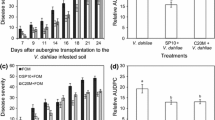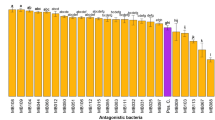Abstract
Seven experimental trials were carried out to evaluate the efficacy of the bacterial strains Achromobacter xylosoxydans AM1 and Serratia sp. DM1 obtained from suppressive soils and from soilless used rockwool substrates (Pseudomonas putida FC6B, Pseudomonas sp. FC7B, Pseudomonas putida FC8B, Pseudomonas sp. FC9B and Pseudomonas sp. FC24B) against Fusarium wilt on rocket caused by Fusarium oxysporum ff. spp. raphani and conglutinans. Along with these strains, two commercial bioproducts (RootShield—Trichoderma harzianum T22; Cedomon—Pseudomonas chlororaphis MA342) were also tested. Different application strategies such as soil treatment (trials I to VI; 107 and 108 CFU ml−1) and root dipping (trial VII; 108 and 109 CFU ml−1) were performed in a glasshouse in order to test the efficacy of the bacterial strains against Fusarium oxysporum ff. spp. raphani and conglutinans. The lowest disease incidence (16.7%) was observed with the application of Achromobacter sp. AM1, Serratia sp. DM1 at 108 CFU ml−1 and Pseudomonas sp. FC9B at 107 CFU ml−1 against F. oxysporum f. sp. conglutinans (experiment I). Maximum plant biomass (5.0 g/plant) was registered in Serratia sp. DM1 at 108 CFU ml−1 treated plants in trial IV. The trials against F. oxysporum f. sp. raphani (experiment II) showed that the application of Pseudomonas sp. FC7B, P. putida FC8B at 108 CFU ml−1 and P. chlororaphis MA342 at 7.5 × 106 CFU ml−1 significantly reduced disease incidence to values ranging between 87% and 92%. The highest plant biomass was recorded with the application of Achromobacter sp. AM1 and P. putida FC6B at 107 CFU ml−1 (3.9 to 4.2 g) carried out 7 days before the artificial inoculation of the pathogens (trial IV). The present study showed the potential biocontrol activity of the bacterial strains Achromobacter sp. AM1, Serratia sp. DM1 and Pseudomonas sp. FC9B against F. oxysporum f. sp. conglutinans and of Pseudomonas sp. FC7B, P. putida FC8B, P. chlororaphis MA342, Achromobacter sp. AM1 and P. putida FC6B against F. oxysporum f. sp. raphani. Growth-promoting activity of biocontrol bacteria used during the trials was observed.
Similar content being viewed by others
References
Akkopru, A., & Demir, S. (2005). Biological control of Fusarium wilt in tomato caused by Fusarium oxysporum f. sp. lycopersici by AMF Glomus intraradices and some rhizobacteria. Journal of Phytopathology, 153, 544–550.
Bora, T., Ozaktan, H., Gore, E., & Aslan, E. (2004). Biological control of Fusarium oxysporum f. sp. melonis by wettable powder formulations of the two strains of Pseudomonas putida. Journal of Phytopathology, 152, 471–475.
Borrero, C., Ordovas, J., Trillas, M. I., & Aviles, M. (2006). Tomato Fusarium wilt suppressiveness. The relationship between the organic plant growth media and their microbial communities as characterised by Biolog®. Soil Biology & Biochemistry, 38, 1631–1637.
Borrero, C., Trillas, M. I., Ordovas, J., Tello, J. C., & Aviles, M. (2004). Predictive factors for the suppression of Fusarium wilt of tomato in plant growth media. Phytopathology, 94, 1094–1101.
Bosland, P. W., Williams, P. H., & Morrison, R. H. (1988). Influence of soil temperature on the expression of yellows and wilt of crucifers by Fusarium oxysporum. Plant Disease, 72, 777–780.
Catti, A., Pasquali, M., Ghiringhelli, D., Garibaldi, A., & Gullino, M. L. (2007). Analysis of vegetative compatibility groups of Fusarium oxysporum from Eruca vesicaria and Diplotaxis tenuifolia. Journal of Phytopathology, 155, 61–64.
Chatterjee, C., & Rai, J. N. (1974). Fusarium wilt of Eruca sativa. Observation on comparative pathogenicity of some strains of Fusarium oxysporum. Indian Phytopathology, 27, 309–311.
Clematis, F., Gullino, M. L., & Garibaldi, A. (2009). Microrganismi isolati da substrati di coltura riciclati per il fuori suolo possono contenere il marciume del colletto del pomodoro. Protezione delle Colture (in press).
De Boer, M., Bom, P., Kindt, F., Keurentjes, J. J. B., van der Sluis, I., van Loon, L. C., et al. (2003). Control of Fusarium wilt of radish by combining Pseudomonas putida strains that have different disease suppressive mechanisms. Phytopathology, 93, 626–632.
Garibaldi, A., Gilardi, G., & Gullino, M. L. (2003a). First report of Fusarium oxysporum on Eruca vesicaria and Diplotaxis sp. in Europe. Plant Disease, 87, 201.
Garibaldi, A., Gilardi, G., & Gullino, M. L. (2006). Evidence for an expanded host range of Fusarium oxysporum f. sp. raphani. Phytoparasitica, 34, 115–121.
Garibaldi, A., Gilardi, G., Pasquali, M., Kejji, S., & Gullino, M. L. (2004). Seed transmission of Fusarium oxysporum of Eruca vesicaria and Diplotaxis muralis. Journal of Plant Disease and Protection, 111, 345–350.
Garibaldi, A., Minuto, A., Grasso, V., & Gullino, M. L. (2003b). Application of selected antagonistic strains against Phytophthora cryptogea on gerbera in closed soilless systems with disinfection by slow sand filtration. Crop Protection, 22, 1053–1061.
Gilardi, G., Chen, G., Garibaldi, A., Zhiping, C., & Gullino, M. L. (2007a). Resistance of different rocket cultivars to wilt caused by strains of Fusarium oxysporum under artificial inoculation conditions. Journal of Plant Pathology, 89, 113–117.
Gilardi, G., Garibaldi, A., & Gullino, M. L. (2007b). Effect of antagonistic Fusarium spp. and of different commercial biofungicide formulations on Fusarium wilt of lettuce. Phytoparasitica, 35, 457–465.
Haas, D., & Défago, G. (2005). Biological control of soil-borne pathogens by fluorescent pseudomonads. Nature Reviews Microbiology, 3, 307–319.
Jayaraj, J., Parthasarathi, T., & Radhakrishnan, N. V. (2007). Characterization of a Pseudomonas fluorescens strain from tomato rhizosphere and its use for integrated management of tomato damping-off. BioControl, 52, 683–702.
Koohakan, P., Ikeda, H., Jeanaksorn, T., Tojo, M., Kusakari, S., Okada, K., et al. (2004). Evaluation of the indigenous microorganisms in soilless culture: Occurrence and quantitative characteristics in the different growing systems. Scientia Horticulturae, 101, 179–188.
Larkin, R. P., & Fravel, D. R. (2002). Reduction of Fusarium wilt of hydroponically-grown basil by Fusarium oxysporum strain CS-20. Crop Protection, 21, 539–543.
Larkin, R. P., Hopkins, D. L., & Martin, F. N. (1996). Suppression of Fusarium wilt of watermelon by non-pathogenic Fusarium oxysporum and other microorganisms recovered from a disease suppressive soil. Phytopathology, 86, 812–819.
Locke, T., & Colhoun, J. (1974). Contribution to a method of testing oil palm seedlings for resistance to Fusarium oxysporum f. sp. elaeidis Toovey. Phytopathologische Zeitschrift, 79, 77–92.
Minuto, A., Clematis, F., Gullino, M. L., & Garibaldi, A. (2007). Induced suppressiveness to Fusarium oxysporum f. sp. radicis lycopersici in rockwool substrate used in closed soilless systems. Phytoparasitica, 35, 77–85.
Moretti, M., Gilardi, G., Gullino, M. L., & Garibaldi, A. (2008). Biological control potential of Achromobacter xylosoxydans for suppressing Fusarium wilt of tomato. International Journal of Botany, 4, 369–375.
Mujeebur, R. K., & Shahana, M. K. (2002). Effects of root-dip treatment with certain phosphate solubilizing microorganisms on the fusarial wilt of tomato. BioResource Technology, 85, 213–215.
Nel, B., Steinberg, C., Labuschagne, N., & Vilioen, A. (2006). The potential of non-pathogenic Fusarium oxysporum and other biological control organisms for suppressing Fusarium wilt of banana. Plant Pathology, 55, 217–223.
Postma, J., Willemsen-de Klein, M. J. E. I. M., Rattink, H., & van Os, E. A. (2001). Disease suppressive soilless culture systems; characterization of its microflora. Acta Horticulturae, 554, 323–329.
Postma, J., Willemsen-de Klein, M. J. E. I. M., & van Elsas, J. D. (2000). Effect of the indigenous microflora on the development of root and crown rot caused by Pythium aphanidermatum in cucumber grown on rockwool. Phytopathology, 90, 125–133.
Ramamoorthy, V., Raguchander, T., & Samiyappan, R. (2001). Induction of systemic resistance by plant growth promoting rhizobacteria in crop plants against pests and diseases. Crop Protection, 20, 1–11.
Sabuquillo, P., De Cal, A., & Melgarejo, P. (2006). Biocontrol of tomato wilt by Penicillium oxalicum formulations in different crop conditions. Biological Control, 37, 256–265.
Santamaria, P., Elia, A., & Serio, F. (2002). Effect of solution nitrogen concentration on yield, leaf element content and water and nitrogen use efficiency of three hydroponically grown rocket salad genotypes. Journal of Plant Nutrition, 25, 245–258.
Siddiqui, Z. A. (2004). Effects of plant growth promoting bacteria and composted organic fertilizers on the reproduction of Meloidogyne incognita and tomato growth. BioResource Technology, 95, 223–227.
Siddiqui, I. A., & Shaukat, S. S. (2004). Systemic resistance in tomato induced by biocontrol bacteria against the root-knot nematode, Meloidogyne javanica is independent of salicylic acid production. Journal of Phytopathology, 152, 48–54.
Yigit, F., & Dikilitas, M. (2007). Control of Fusarium wilt of tomato by combination of fluorescent Pseudomonas, non-pathogen Fusarium and Trichoderma harzianum T22 in greenhouse conditions. Plant Pathology Journal, 6, 159–163.
Acknowledgment
This research was supported by the Italian Ministry of Education, University and Research.
Author information
Authors and Affiliations
Corresponding author
Rights and permissions
About this article
Cite this article
Srinivasan, K., Gilardi, G., Garibaldi, A. et al. Efficacy of bacterial antagonists and different commercial products against Fusarium wilt on rocket. Phytoparasitica 37, 179–188 (2009). https://doi.org/10.1007/s12600-009-0024-9
Received:
Accepted:
Published:
Issue Date:
DOI: https://doi.org/10.1007/s12600-009-0024-9




